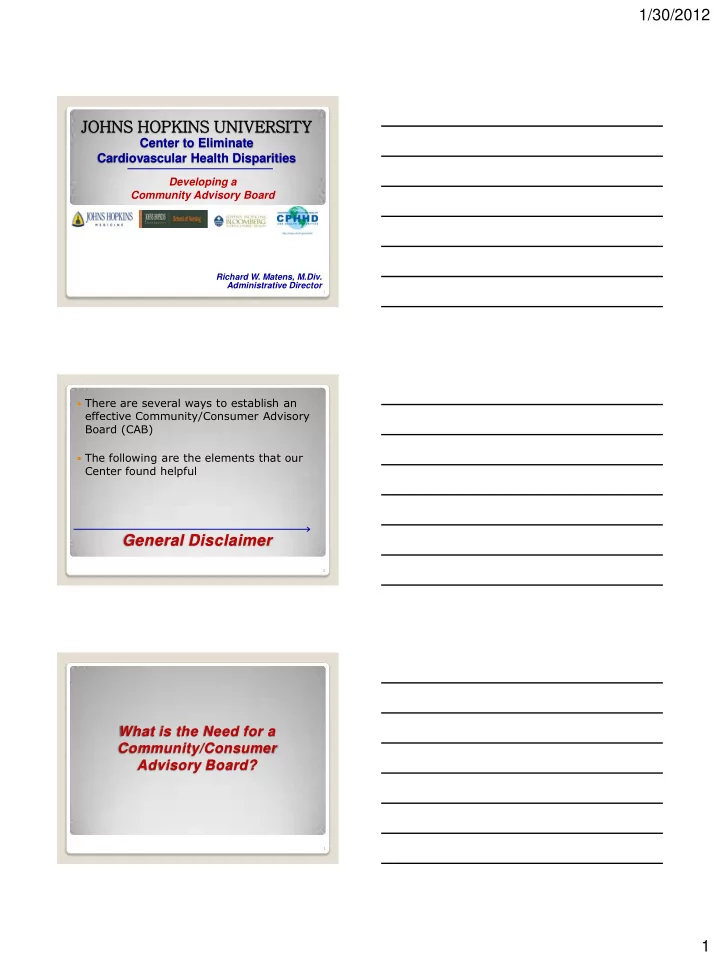

1/30/2012 JOH JOHNS HOPK HOPKINS UNIV UNIVERSITY Center to Eliminate Cardiovascular Health Disparities Developing a Community Advisory Board Richard W. Matens, M.Div. Administrative Director 1 There are several ways to establish an effective Community/Consumer Advisory Board (CAB) The following are the elements that our Center found helpful General Disclaimer 2 What is the Need for a Community/Consumer Advisory Board? 3 1
1/30/2012 “Bummer of a birthmark, Hal.” Target Community 4 Historically (and unfortunately), this is the way many community members have felt about their role/relationship with Hopkins research. A CAB seeks to improve that role and relationship. What is the Need for a CAB? 5 Funding Requirements Effectiveness of Center Sustainability of Center Building a Bridge with the Community The Need to “Keep it Real” What is the Need for a CAB? 6 2
1/30/2012 Setting the Membership Parameters Defining the Community Input Needs of the Center General Membership Parameters Establishing the Number of Members Expertise and Representation – Not By Specific Persons Membership Composition 7 Specific Community Input Needs Funding Requirements? Objectives of the Center Types of Input (Proactive/Reactive) Stages/Levels of Input Level of Communication Input Desired by the Community 8 General Membership Parameters Health Care Providers Community Based Organizations Community Members Patients Experts in Certain Areas ◦ Marketing ◦ Public Health Initiatives ◦ Faith-based Communities 9 3
1/30/2012 Size Matters! Too Small – chance of not getting adequate input Too Large – chance of group not being effective, not coming to consensus We chose 30 as our optimum number Number of Members Needed 10 Not primarily based on individuals: If you base it on individual people you are likely to have serious gaps to meeting the needs for the CAB Tom cannot be replaced – Tom’s skills and knowledge can Membership Composition 11 Membership Composition Based on Representation & Expertise Skill Community Affiliation Network Knowledge 12 4
1/30/2012 So we have decided on the expertise and representation types and total number of members, now we must determine the number of individuals from each skill set or type of representation. Some redundancy is good…too much skews the picture Composition Breakdown 13 Now we need to see what our completed CAB would look like in the perfect world… So we set up a matrix Setting up a Visual Matrix 14 Visual Matrix American Heart Association (1) Food Policy (1) Baltimore City Health Department (1) Foundation (1) Baltimore County Dept of Health (1) Health Care Access/Insurance (1) Business/Marketing (1) Morgan State University (1) Community-based Organizations (2) Monumental Medical Society (1) Community Health Worker (1) Neighborhood/Community (3) Coppin State University (1) Patients (5) DHMH (2) Pharmacy (1) Elected Officials (1) Physical Activity (1) Faith-based (1) School System (1) Federally Qualified Health Center (1) University of Maryland (1) 15 5
1/30/2012 Membership Selection Once the matrix is set, now you look at specific individuals to fill the designated slots. Sara Neighborhood Jones Resident Marketing Expert 16 Membership Retention/CAB Sustainability Primary Principle: Communication 17 7 Communication Principles for CAB Development & Maintenance 1) Respectful Communication 2) Proactive Communication 3) Consistent Communication 4) Transparent Communication 5) Receptive Communication 6) Responsive Communication 7) Conciliatory Communication 18 6
1/30/2012 7 Communication Principles for CAB Development & Maintenance 1) Respectful Communication • Just as you are the experts in research, they are the experts in community 2) Proactive Communication Communicate up front expectations and • limitations 3) Consistent Communication • Stick to a schedule don’t go an extended period without communicating 19 7 Communication Principles for CAB Development & Maintenance 4) Transparent Communication Don’t Hide or Misguide • 5) Receptive Communication Active Listening – Openness to Change • 6) Responsive Communication Follow-up is Key; Answer What is Asked • 7) Conciliatory Communication • If You Screw Up, Admit it! 20 Thank You! Richard W. Matens rmatens1@jhmi.edu Conclusion/Questions ???????? 21 7
Recommend
More recommend